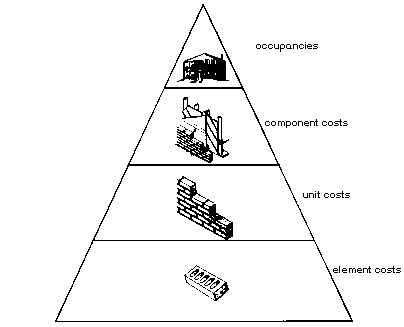Pyramid of Costs
The inductive approach to valuation works from parts to a whole, or particulars to generals. A total building cost is the sum of its elements: elements build units, units build components, and components build occupancies. This is the fundamental principle of the inductive approach and the basis for the Total Component methodology.
In Commercial Express, element costs (for example: bricks, mortar, labor hours and other basic costs) are combined into units or unit-in-place costs (one square foot of face brick veneer). Units are combined into components or component-in-place costs (one square foot of an entire wall, including brick veneer, sheathing, studs, insulation, etc.). And finally, components are further combined into the total cost for an entire building. The process of repetitively combining the smallest elements into larger units, components, and complete building costs is called the pyramid of costs.

| Yes | No |